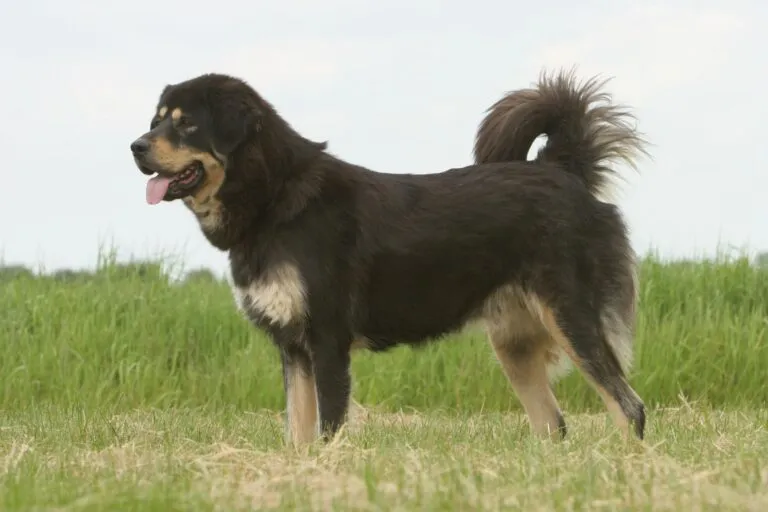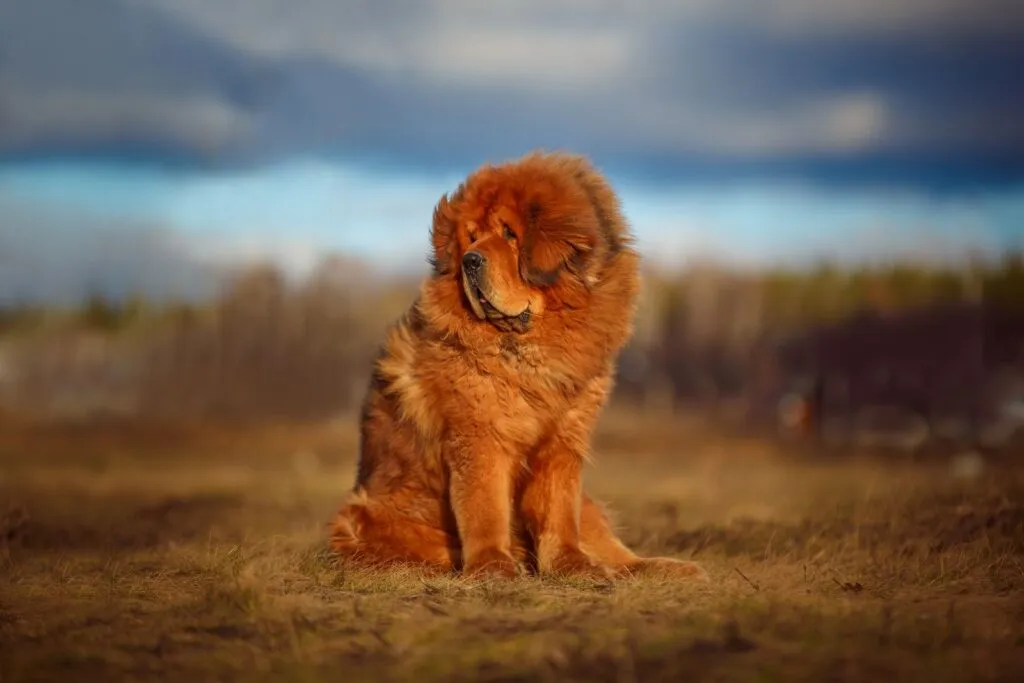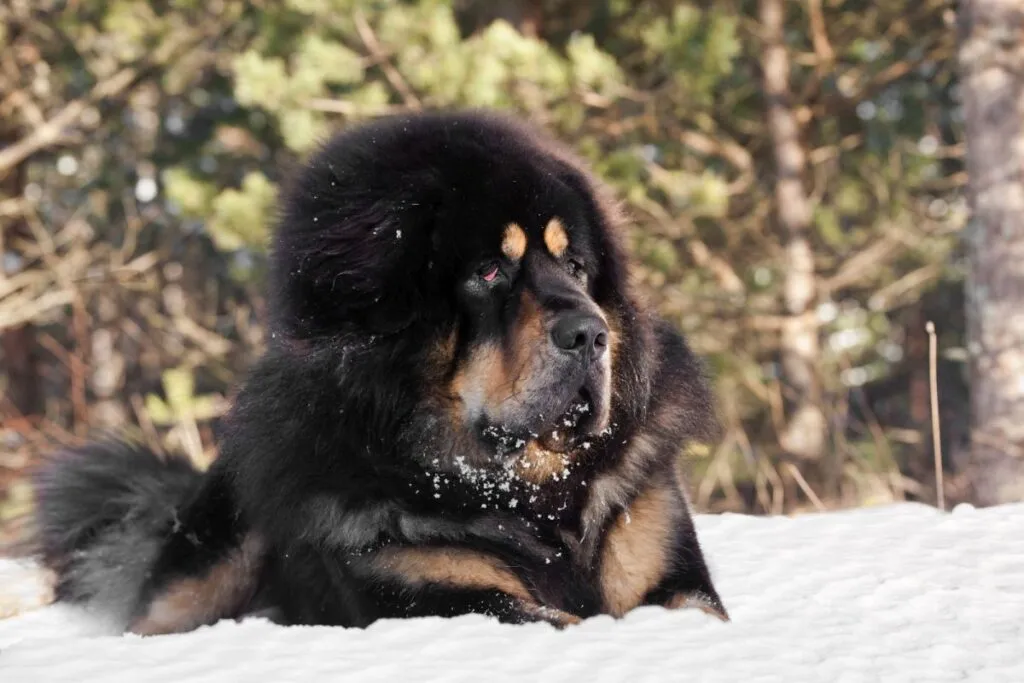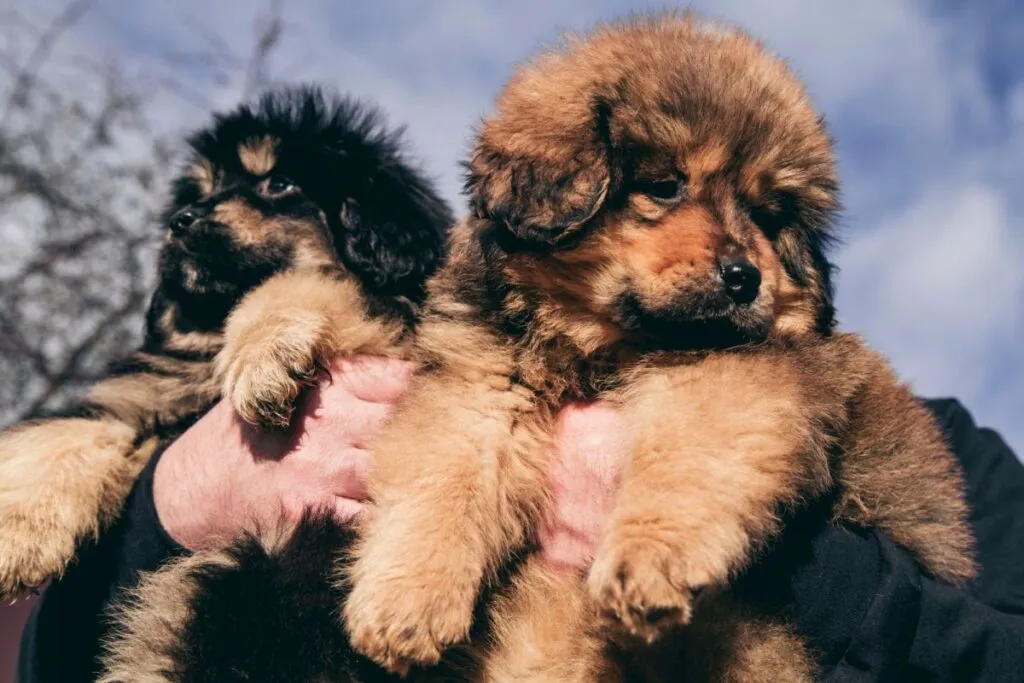Medium Size Poodle
Originating from the Himalayas, the Tibetan Mastiff is considered one of the oldest dog breeds of the East. Its powerful stature and inherent protective instinct make it a formidable guardian of house, farm, and livestock to this day. Other names for this impressive breed include Tibetdogge and Do Khyi.

© CALLALLOO CANDCY / stock.adobe.com
The Tibetan Mastiff is an impressive four-legged friend with a strong protective instinct.
Even Aristotle was fascinated by this large dog from the distant Himalayan mountains, describing it as a dog with “colossal bones, muscular, heavy, large-headed, and equipped with a broad snout …”. Marco Polo, who travelled through Asia in the 13th century, also could not resist the mighty mountain dog. He described it in his travelogue as “as large as a donkey, with a voice as mighty as a lion’s”.
Indeed, with a shoulder height of at least 66cm, male Tibetan Mastiffs belong to the large dog breeds. Although they don’t reach the size of a donkey, females are at least 61cm tall and thus somewhat smaller than males. Other names for this imposing dog breed include Tibet Dogge, Tibet Mastiff, Do Khyi, and Tibetan Mastiff.
Depending on gender, size, and body structure, the weight of this impressive breed can range from 36kg to 72kg. Their deep bark and dense, double coat, forming a mane around the neck and shoulders, also give them a lion-like appearance.
Just as heavily feathered as the neck, the tail and upper part of the hind legs of the Tibetdogge are also well-covered. The rest of the body is equally well-haired. The thick fur, with a strong undercoat in winter and thick, straight top coat, offers reliable protection against cold, wind, and weather. Its fur has perfectly adapted to the harsh climate of its homeland.
In spring, when the valleys in the Himalayas get warmer, the Tibetan Mastiff sheds its dense undercoat, giving it a significantly leaner appearance overall.
The Tibetan Mastiff has truly “thick fur”. It is very resistant to weather and robust, but never silky, curly, or wavy. Colour-wise, it comes in the following variants:
White markings in the form of a small star on the chest or on the toes are possible in all colour variants.
 © Tatyana / stock.adobe.com
© Tatyana / stock.adobe.com
Despite its powerful and heavy appearance, the Do Khyi can be very athletic and nimble. The ears, which are relatively small to medium-sized compared to its strong and broad head, point forward when alert. It carries its heavily feathered rod curled over its back. Always vigilant, even when it appears sleepy, nothing escapes this born guard dog.
The instinct to guard its territory is in the Tibetan Mastiff’s blood. Suspicious of strangers, loyal to its owner, self-assured and fearless in its presence, it naturally possesses all the characteristics that define a guard dog. Its territorial behaviour is strongly pronounced and needs no additional encouragement.
Even as a family dog, it should be able to fulfil its innate guarding role. However, one must teach it the limits of its protective instincts from puppyhood. Only consistent training and extensive socialisation will ensure that the Tibetan Mastiff accepts strangers in its territory.
If this is neglected, the powerful Tibetan will be hard to manage in crucial situations. Protecting its family and territory is paramount to it, and it won’t stop with a simple “No”. When in “protection mode”, it doesn’t respond to commands and can become a danger to others.
Despite its primal instincts, aversion to the unfamiliar, and stubbornness, the Tibetan Mastiff can certainly be trained to become a pleasant and reliable companion dog. After all, it is not only stubborn but also highly loyal to its family.
It forms a deep bond with its people and will willingly follow them, provided it sees a reason behind their commands.
Blind obedience is not to be expected from it. It is too intelligent and mentally independent for that. However, those who approach the Tibetan Mastiff with a mix of understanding and firmness will be surprised by how quickly it can learn – if it wants to.
Constant repetition or demonstration of certain exercises quickly bores it. Therefore, it is wise to package training goals into varied, creative, and positive activities.
Especially during the crucial first 16 weeks of life, the Tibetan Mastiff should not be overwhelmed. Accept if your dog initially reacts nervously, fearfully, or dismissively. Give it the time it needs to learn. It can take up to four years until the Do Khyi is characteristically mature and mentally developed.
Do not let this discourage you or sway you from your goal. Avoiding new encounters with people and animals will not help. Gently introduce it to new experiences. Your patience and endurance will pay off in the end. Everything the Tibetan Mastiff learns in its youth, it will accept without issue for its entire life.
 © annatronova / stock.adobe.com
© annatronova / stock.adobe.com
Even if its occasionally bored expression suggests otherwise, the Tibetan Mastiff enjoys being in company. Close family connection should be a top priority in its keep. It needs to be close to its people, alongside, of course, requiring plenty of exercise.
However, it has a moderate exercise drive and is also content with shorter walks.
Nevertheless, as an original guard and herding dog, your Do Khyi must have sufficient time outside. Therefore, a large garden where it can roam as it wishes should be essential in its home.
While lively and playful outdoors, the Tibetan Mastiff is quite calm and good-natured at home. It doesn’t bark unnecessarily and gets along well with children. However, due to its size and power, it should never be left alone with small children.
Caution is also advised when friends are visiting, especially if things get a bit wild between the children. The Tibetan Mastiff might feel it needs to intervene and protect “its” children.
To control its protective instinct, comprehensive socialisation from the beginning is essential. The more people, animals, sounds, and smells it experiences as a young dog, the less it will be startled by things as an adult.
Sometimes, less is more when it comes to coat care. Frequent bathing or shampooing is not only unnecessary for dogs but also harmful. For the well-coated Tibetan Mastiff, brushing a few times a week is usually enough.
However, during the coat change, especially in spring when higher temperatures cause its dense undercoat to shed, your dog must be brushed daily. You will also notice more hair around the house.
Apart from coat care, you should check and clean its ears and teeth at least once a week. Nails should be trimmed once or twice a month, depending on their growth.
To this day, the Tibetan Mastiff is one of the rarer dog breeds, which is certainly advantageous for its health.
Contrary to China, where the Tibetan Mastiff has recently become a status symbol for the wealthy, breeding and selling this breed in Europe is hardly profitable. Thus, the few official Do Khyi breeders focus on preserving these special dogs, their healthy Constitution, unique nature, and impressive appearance.
Thanks to this careful breeding, extensive breeding suitability tests, and numerous health tests, the breed remains largely free from health issues.
Apart from the hip dysplasia common to all large dogs, the Tibetan Mastiff is robust against breed-specific ailments.
To prepare well, consider the nutrition of your Do Khyi. Discussions with your breeder and other Tibetan Mastiff owners will provide numerous tips for optimal feeding.
Most breeders also give buyers a detailed feeding plan for the first weeks at the new home.
After about six months, the puppy food should gradually be switched to adult food. This is important as it gradually reduces the food’s energy density, preventing the dog from growing too fast.
When choosing the right food for your adult Do Khyi, it’s about quality, not quantity – similar to any healthy diet. Despite its size, the Tibetan Mastiff requires surprisingly small portions if it receives all essential nutrients in sufficient form.
Small portions also reduce potential gastrointestinal problems and the risk of dreaded gastric torsion.
Their instinctive guarding and territorial protection are closely linked to this breed’s history. For over 3000 years, the Tibetdogge likely served the nomadic herders of the Himalayas as a flock guardian and the Tibetan monks as a watchdog for their monasteries.
In the inhospitable expanses of the Himalayan highlands, this amazingly robust, independent, and modest dog became a close partner to the local population. Depictions of this shepherd dog type in the “Wheel of Life” on ancient Thangkas and paintings show the high regard the Tibetans had for their dogs.
In Europe, the first mentions of this majestic dog with its impressive appearance and natural strength came through the famous writings of Marco Polo (1271).
Fascinated by these stories, leading European cynologists dedicated their studies to the breed, often describing it as the origin of all combat and shepherd dogs, as well as all molosser-type dogs.
However, supposed close genetic relationships with breeds like the Mastiff and dogge, indicated by names like Tibet dogge and Tibet Mastiff, had to be revised through DNA research. Results showed that the Do Khyi is a primitive dog, genetically scarcely influenced by other dogs over centuries.
Due to its remote homeland, the Himalayan breed remained isolated for millennia. The first verified import of a Do Khyi to Europe was a gift from the then Viceroy of India, Lord Hardinge, to Queen Victoria of England in 1847.
About thirty years later, King Edward VII, then Prince of Wales, brought two more dogs to Britain. The first Tibetan Mastiff Club was established in 1931. However, World War II soon ended these early European breeding attempts.
Only by the 1970s did breeders in Europe and America specifically import dogs from Nepal to establish their breeding lines in Europe and America.
Extensive health checks, vaccinations, tests, and the relatively high upkeep of these large and demanding dogs justify the comparatively high price of puppies. These usually start at £1,500.
Additionally, females only come into season once a year, meaning the wait for a puppy can be longer. However, the high puppy price and wait time also prevent unconsidered purchases of a Tibet Mastiff.
If you are seriously interested in this breed, use the waiting time to thoroughly learn about breeders and the breed. Meet with your breeder or other Do Khyi owners to experience the breed’s characteristics firsthand and prepare well for life with your new dog.
 © karyakinvitaliy / stock.adobe.com
© karyakinvitaliy / stock.adobe.com
It’s clear that the Tibetan Mastiff is not a dog for beginners. Its wilful nature and protective instincts require extensive knowledge and a delicate touch from the owner.
However, those with the necessary experience and the time and desire to fully commit to this unique canine personality from the Himalayas will be overwhelmed by its loyalty and devotion.
If you have a soft spot for the Tibetan Mastiff, you might also like these breeds:
Fans of the Bearded Collie agree that those who aren't familiar with this dog breed simply have to get acquainted with it. And those who have experienced how a Bearded Collie bolts across meadows with its flowing fur, how it rolls around full of energy and joy and how it attentively and observantly takes into account its owners wishes become simply addicted to this original dog breed and its unique charm.
The Goldendoodle isn't a breed, but a pairing between Golden Retrievers and Medium or Standard Poodles. Marketed as a low-maintenance dog for allergy sufferers, this hybrid is enjoying increasing popularity amongst dog lovers, similar to the Labradoodle.